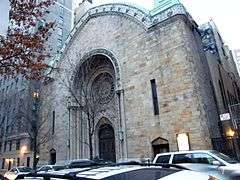B'nai Jeshurun (Manhattan)
|
Congregation B'nai Jeshurun Synagogue and Community House | |
|
Congregation B'Nai, March 2009 | |
   | |
| Location | 257 W. 88th St. and 270 W. 89th St., New York, New York |
|---|---|
| Coordinates | 40°47′24″N 73°58′35″W / 40.79000°N 73.97639°WCoordinates: 40°47′24″N 73°58′35″W / 40.79000°N 73.97639°W |
| Area | 0.9 acres (0.36 ha) |
| Built | 1917 |
| Architect | Schneider,Walter S.; Et al. |
| Architectural style | Late 19th And Early 20th Century American Movements, Semitic Revival |
| NRHP Reference # | [1] |
| Added to NRHP | June 2, 1989 |
B'nai Jeshurun is a synagogue in the Upper West Side of Manhattan, New York City.
History
Founded in 1825, Bnai Jeshurun was the second synagogue founded in New York and the third-oldest Ashkenazi synagogue in the United States.
The synagogue was founded by a coalition of young members of congregation Shearith Israel and immigrants and the descendants of immigrants from the German and Polish lands. It was the stated intention to follow the "German and Polish minhag (rite)."[2] The order of prayers followed that of the Ashkenazi Great Synagogue of London and sought the guidance of the British chief Rabbi Solomon Hirschell on matters of ritual. The congregation dedicated its first building on Elm Street in Manhattan in 1827.
The first rabbi, Samuel Isaacs, was appointed in 1839. By 1850, the congregation had grown large enough to make it necessary to build a new synagogue on Green Street.
In 1865, the congregation moved yet again, to a new building on 34th Street, the parcel later part of the site of the flagship Macy's store. Driven by the rapid expansion of the city, they moved yet again in 1885 to Madison Avenue at 65th Street. That building was designed by Rafael Guastavino and Schwarzmann & Buchman.
The present building, located at 257 West 88th Street between Broadway and West End Avenue was dedicated in 1917. It was designed by Henry B. Herts, a congregant and celebrated theater architect, with Walter S. Schneider.[3] In addition to its place on the National Register of Historic Places, the synagogue was included in the New York City Riverside Drive-West End Historic District created in 1990. The muqarna-studded ceiling was redesigned following its collapse during renovations in the early 1990s and was replaced with a future-invoking space frame back-lit to simulate a nighttime sky .
Breakaway congregations
B'nai Jeshurun's original founders broke from the city's only synagogue, Shearith Israel, in 1825, in order to create an Ashkenazi congregation. Subsequently, B'nai Jeshurun members broke away to form new shuls several times.
In 1828, at a time of rapid growth in the New York Jewish community, a group left B'nai Jeshurun to found Ansche Chesed.[4]
In 1845, Temple Shaaray Tefila was founded by 50 primarily English and Dutch Jews who had been members of B'nai Jeshurun.[5][6]
Affiliation
B'nai Jeshurun took a leading role in founding the Board of Directors of American Israelites in 1859. When the Board of Delegates merged with the (Reform) Union of American Hebrew Congregations in 1878 the congregation went along, but in 1884 it left the Reform Movement. Two years later, it also supported the founding of the Jewish Theological Seminary of America (JTS) in 1886, a school formed to support Orthodoxy in combating the Reform movement.
In 1889, the congregation published its own edition of the prayer book.
When Solomon Schechter used JTS to create a more conservative set of reforms to traditional Judaism, B'nai Jeshurun joined his United Synagogue of America, now the United Synagogue of Conservative Judaism.
In the 1990s the congregation left the Conservative movement and is now independent.
Contemporary
A spiritual and demographic renaissance began in 1985, with the arrival of Rabbi Marshall Meyer.
A "Stonewall Shabbat Seder" was first held at B’nai Jeshurun in 1995.[7][8]
Notable clergy
- Rabbi Stephen Samuel Wise (1893-1906)
- Rabbi Judah Leon Magnes (1911-1912)
- Rabbi Israel Goldstein (1918-1960)
- Rabbi William Berkowitz (1952-1984)
- Rabbi Marshall Meyer (1985-1993)
- Rabbi Rolando Matalon (1986-)
References
- ↑ National Park Service (2009-03-13). "National Register Information System". National Register of Historic Places. National Park Service.
- ↑ Sarna, Jonathan, American Judaism, Yale University Press, 2004, p. 56.
- ↑ Kathleen LaFrank (March 1989). "National Register of Historic Places Registration: Congregation B'nai Jeshurun Synagogue and Community House". New York State Office of Parks, Recreation and Historic Preservation. Retrieved March 25, 2011. See also: "Accompanying six photos".
- ↑ Archived November 21, 2008, at the Wayback Machine.
- ↑ "Our History and Vision". Shaaraytefilanyc.org. Retrieved January 7, 2013.
- ↑ Rabbi Kerry M Olitzky, Marc Lee Raphael (1996). The American Synagogue: A Historical Dictionary and Sourcebook. Greenwood Publishing Group. Retrieved January 7, 2013.
- ↑ Mark Horn. "The Stonewall Seder". Retrieved November 26, 2014.
- ↑ Guguhj (1999-06-29). "BEHIND THE HEADLINES Gay Jews recount dual struggle on anniversary of Stonewall Riots | Jewish Telegraphic Agency". Jta.org. Retrieved 2015-11-06.
External links
| Wikimedia Commons has media related to B'nai Jeshurun (Manhattan, New York). |


